Introducing SheilaMoto7000! The world’s first female-form auto-morphing motobot! SheilaMoto7000: The perfect motorcycle that also cooks breakfast!
What’s that you say? Such a machine doesn’t exist? Well, until it does we’re keeping Triumph’s Street Triple R on our Sexiest Bikes of the Decade list. Selected as Motorcycle of the Year 2009 here on Motorcycle.com, Triumph’s Street Triple R has remained a staff favorite since its introduction in that same year.
The up-spec R iteration brings fully adjustable front and rear suspension, along with radial-mount front brake calipers, to the standard Street Triple – making a smart, entertaining bike we liked into a bike we loved instantly. The R’s brakes and suspension are carryovers from the supersport Daytona 675, while the Daytona’s donor 675cc inline-Triple was retuned and remapped with a low-end torque bias for service in the Street Triple models.
Only a few months ago Troy Siahaan informed us that the Street Triple R’s bigger brother, the venerable 1,050cc Speed Triple, lost what was perhaps its most distinctive visual feature: twin round headlights. The iconic dual headlight look is retained but now the lights are pentagonal in shape, and for 2012 the Street Triple R gets the same style lamps.
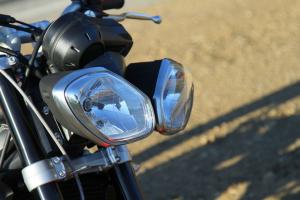 Triumph has taken a humble approach to touting other updates for the STR, as press materials are light on details with respect to changes for the fresh-faced middleweight streetfighter. However, we learned that a number of subtle, as well visually unnoticeable, refinements join the redrafted headlamps as updates for the 2012 STR.
Triumph has taken a humble approach to touting other updates for the STR, as press materials are light on details with respect to changes for the fresh-faced middleweight streetfighter. However, we learned that a number of subtle, as well visually unnoticeable, refinements join the redrafted headlamps as updates for the 2012 STR.According to freelance journalist Alan Cathcart’s report, Triumph remedied an issue with the detent spring in the transmission, ostensibly making the 2012 model a smoother, more precise shifting bike. Additionally, the R’s fueling was recalibrated. Triumph’s Simon Warburton explains in Cathcart’s article that the new fuel maps resemble a two-mode mapping (Sport and Leisure), with the EFI system automatically applying different ignition maps depending on how rapidly the throttle is opened rather than just the throttle’s position.
Warburton says, in essence, the end result is a more refined throttle response during tamer, slower riding, while aggressive throttle inputs are rewarded with snappy, quick-revving power.
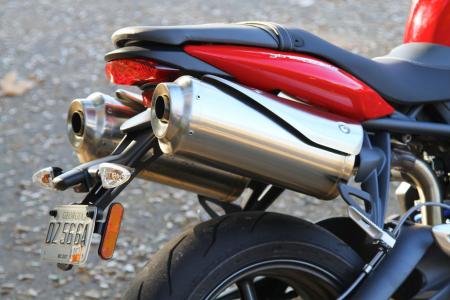 It’s difficult to notice in photos, but the exhaust canisters now have a brushed-steel finish, where last year’s model has a chrome finish. The rider’s footpeg heel guards get the same treatment. It’s difficult to notice in photos, but the exhaust canisters now have a brushed-steel finish, where last year’s model has a chrome finish. The rider’s footpeg heel guards get the same treatment. |
| Anticipating the Next Great Naked Middleweight Streetbike Bout | ||||||||||||||||||||||||||||||||||||||||||||||||||||||||||||||||||
| The Street Triple has obliterated any class-competitive contenders daring to step into the ring. But for 2012 the naked middleweight funster Triumph has some serious competition in the form of Ducati’s all-new Streetfighter 848. Just as the Street Triples are stripped down, retuned versions of Triumph’s Daytona 675 supersport, so too is the Streetfighter 848 a repurposed, friendlier-for-the-street model born from Ducati’s middleweight supersport, known simply as the 848 EVO. However, the Streetfighter boasts something that neither the Street Triple nor even the 848 offers: rider-manageable traction control. But factor out that handy rider aid for a minute, and the Streetfighter still brings some serious punch in the form of its powerful, torquey 849cc Twin and potent radial-mount Brembo brakes. The SF 848 also wears sticky Diablo Rosso Corsa tires.
Our most recent dyno result for the supersport 848 EVO saw a little less than 119 peak hp joined by 62.0 ft-lbs of torque. The Streetfighter’s street-tune biased Twin will likely churn out something closer to 110 hp. Detuning aside, that’s still a considerable advantage to the 95 hp and 44 ft-lbs we saw from a 2011 Street Triple R during our 2011 Naked Middleweights Shootout. At the moment it seems the Triumph’s biggest advantages are its 23-pound (wet) weight savings and $3400 less costly MSRP. Of course, this is a battle between paper lions. We won’t know the whole truth for a few months yet while we await our chance to get a stateside Streetfighter 848 in our hands. In the meantime, here’s a comparative chart to see how they match up on specs.
| ||||||||||||||||||||||||||||||||||||||||||||||||||||||||||||||||||
Cathcart, riding a Euro-spec model, points out the switch from Dunlop to Pirelli rubber on the ’12. But where he says his bike was shod with dual-compound Diablo Supercorsa Pros, our U.S.-spec test unit wore the Diablo Rosso Corsa tire. (Interestingly, the static images in Cathcart’s review show the tires on his bike are also the Rosso Corsa.) Regardless of which Pirelli Diablo model is on your 2012 STR you’re rewarded with excellent grip within minutes of starting your ride thanks to the tire’s quick warm-up time. Handling performance is steady at speed with responsive but predictable turn-in for cornering.
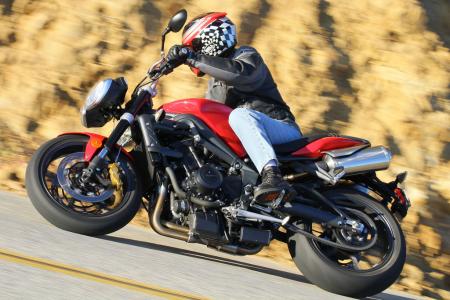 Chassis geometry remains the same, allowing the Street Triple R to continue its reputation as an ideal canyon carving motorcycle. New Pirelli rubber warms up quickly for lots of grip, matched by excellent overall handling performance. Chassis geometry remains the same, allowing the Street Triple R to continue its reputation as an ideal canyon carving motorcycle. New Pirelli rubber warms up quickly for lots of grip, matched by excellent overall handling performance. |
The softer, satiny look of brushed steel replaces the gleaming chrome surfaces of the exhaust (now with thinner-walled headers) and footpeg heel guards. The clutch and alternator covers now sport a Triumph logo, while the name badge on the fuel tank has taken on a simpler, more contemporary look. Additionally, the cam cover is now magnesium for weight savings and new cylinder liners are said to help reduce engine noise.
This latest iteration of the STR remains a familiar beast, as none of the upgrades and changes altered the bike’s open, upright ergonomic layout. The 31.7-inch saddle height is retained, as is the seat’s thin padding near its front edge. This thin seat complaint is one of our biggest gripes with the STR, so in the scheme of things, that says a lot about the bike’s near-perfect state.
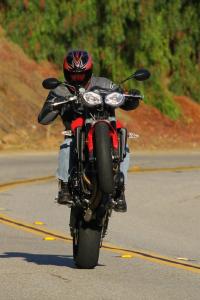 The improvements to the transmission that Triumph says it implemented seem transparent to us since the STR’s gearbox is as smooth as it’s always been in our experience. We’ve rarely taken issue with switching cogs on the Street Triple models. Same goes for the smooth throttle response. The 675cc inline-Triple’s predictable, linear power curve has always been one the bike’s best attributes – thankfully nothing here has changed for the worse.
The improvements to the transmission that Triumph says it implemented seem transparent to us since the STR’s gearbox is as smooth as it’s always been in our experience. We’ve rarely taken issue with switching cogs on the Street Triple models. Same goes for the smooth throttle response. The 675cc inline-Triple’s predictable, linear power curve has always been one the bike’s best attributes – thankfully nothing here has changed for the worse.The mill spins up aggressively, starting around the 8K rpm mark, when grabbing a healthy amount of throttle. This is perhaps the newly calibrated EFI in play. But fueling on this Trumpet model is generally seamless, so we’d need to ride a 2011 against the new 2012 to fully suss out if the new bike’s throttle response is markedly different than last year.
Stainless-steel brake lines as standard equipment help the dual four-pot radial-mount Nissin calipers provide communicative feedback and plenty of stopping force to reel in the STR’s 416-pound wet weight. Last, but most definitely not least, the raspy exhaust note – with appealing burble and occasional Pop Pop on overrun – that we’ve come to love continues to sing its song on the 2012 bike.
The Street Triple R’s notable styling changes and modest mechanical updates, while not earthshaking, nevertheless keep this awesome streetbike at the forefront of a list of bikes we can’t get enough of.
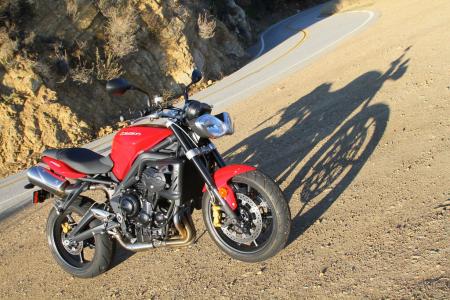 The Street Triple R has so few flaws and does so much right. We never tire of riding this motorcycle. The Street Triple R has so few flaws and does so much right. We never tire of riding this motorcycle. |
An unexpected bonus in light of Triumph’s efforts to keep this bike fresh is an MSRP unchanged from 2011 pricing: The 2012 Street Triple R retails for $9599 ($8899 for the standard Street Triple) and is available in Crystal White, Phantom Black or Diablo Red.



 10:07 PM
10:07 PM
 Unknown
Unknown


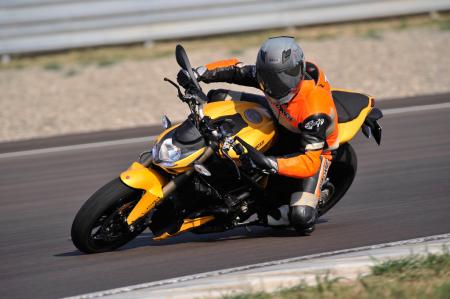 Ducati’s new 848 Streetfighter has the Street Triple R squarely in its sights.
Ducati’s new 848 Streetfighter has the Street Triple R squarely in its sights. Posted in:
Posted in: 




0 comments:
Post a Comment